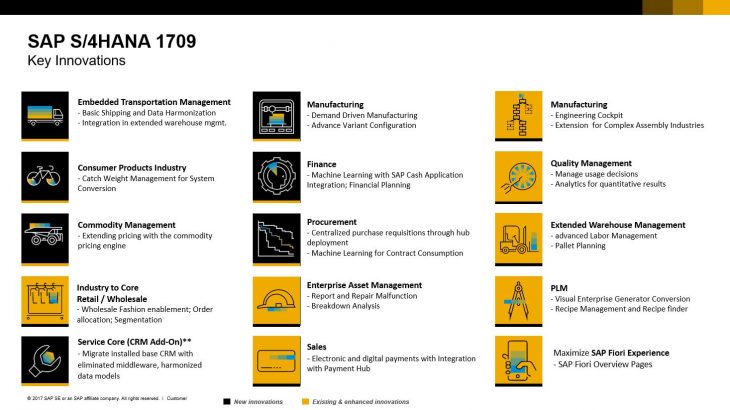This blog post will provide S/4HANA On-Premise releases version updates at a high level to get the glance of innovations delivered as part of each release.
What is SAP S/4HANA?

SAP Business Suite 4 SAP HANA (short SAP S/4HANA), is the next-generation business suite, fully built on the most advanced in-memory platform – SAP HANA. It is designed with the most modern user experience – SAP Fiori – and can be deployed on-premise, in the cloud or hybrid. SAP S/4HANA delivers instant value across business functions and industries with the ultimate sophistication: simplicity.
SAP S/4HANA – Digital Core
SAP S/4HANA is SAP’s next-generation Digital Core
- Optimized for SAP HANA
- New architecture and data models
- Principle of one
- Renewed applications
- Fiori based User Experience
- Cloud & on premise deployment models
SAP S/4HANA (“High-Performance Analytic Appliance”) is SAP’s ERP for large enterprises. It is the successor of SAP R/3 and SAP ERP and is optimized for SAP’s in-memory database SAP HANA.
The offering is an Enterprise Resource Planning software package meant to cover all day-to-day processes of an enterprise (for example, order-to-cash, procure-to-pay, plan-to-product, and request-to-service) and core capabilities. It integrates functions from lines of businesses as well as industry solutions, and also re-integrates portions of SAP Business Suite products such as SAP SRM, SAP CRM and SAP SCM. However SAP Business Suite 4 only runs on the SAP HANA database, and thus it is packaged as one product: SAP S/4HANA. SAP’s classical R3, ERP and ECC based business suite and related products were designed to run on several database platforms, including those from Oracle, Microsoft and IBM.
The platform SAP HANA has been available since 2010, and SAP applications like SAP ERP and the SAP Business Suite have been able to run on the SAP HANA database and/or any other database.
The launch of the new suite, called SAP S/4HANA, took place on 3 February 2015 at the New York Stock Exchange. The event introduced cloud and on-premise editions and launched the on-premise edition.
The S/4HANA product offering consists of two editions: SAP S/4HANA On-Premise and SAP S/4HANA Cloud.
SAP S/4HANA On-Premise is similar in terms of coverage, functionality, industry-specific support, and localization to the current SAP Business Suite (in 39 languages, 64 country versions).
SAP S/4HANA 1511
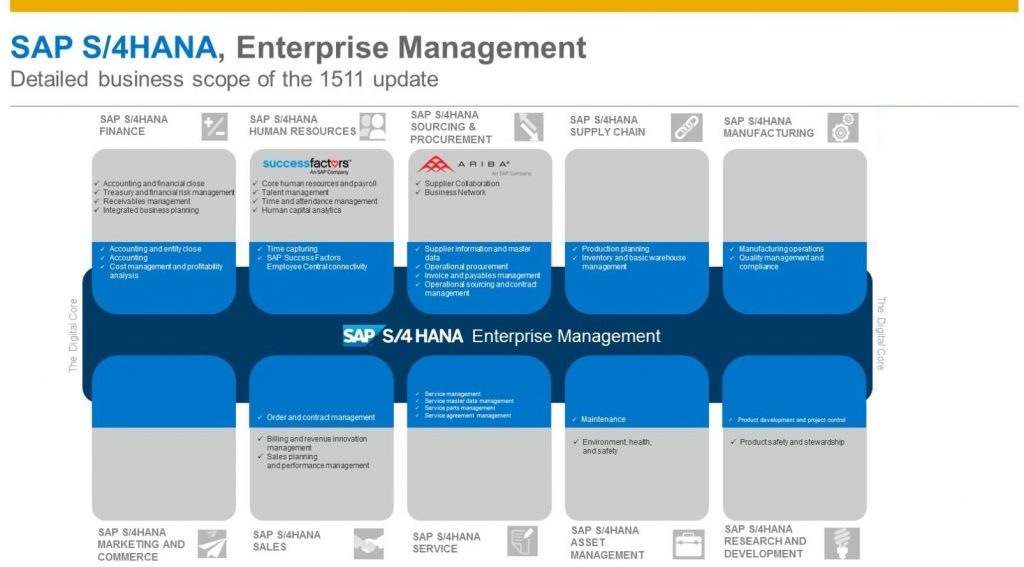
This is a major milestone as part of our roadmap to help customers across industries and regions drive their digital transformation with the next generation business suite, SAP S/4HANA delivers a massive wave of simplification and innovation in the core, covering the mission-critical business processes across lines of business: such as in finance, sales, service, marketing, commerce, procurement and sourcing, manufacturing, supply chain, asset management, research&development, and human resources.
Enterprises can now drive end-to-end digitized operations across their key business functions via a fully digitized enterprise management solution – named SAP S/4HANA Enterprise Management.
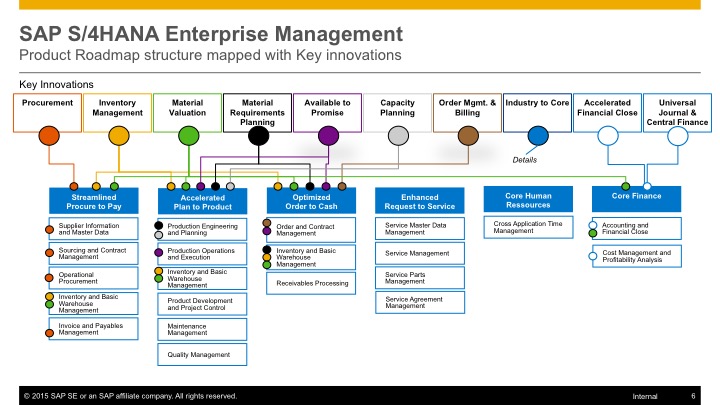
SAP S/4HANA 1610
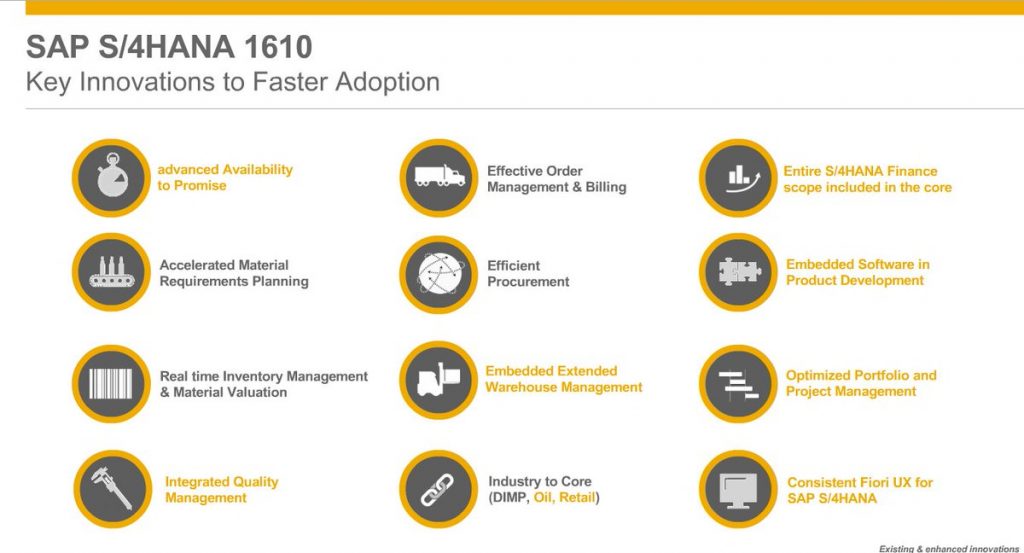
With brand new functions and significant simplifications across lines of business (LoB), the addition of the full SAP S/4HANA Finance scope, and the SAP Fiori 2.0 user experience, SAP S/4HANA 1610 continues where its predecessor left off on its mission to reinvent ERP for the digital age. Here we take a look at some of these highlights in more detail.
From the start, SAP S/4HANA was designed to enable businesses to both master the challenges and leverage the benefits of digitalization for businesses. As the modern digital core, it serves as the nerve center of the enterprise. Built on the SAP HANA platform, SAP S/4HANA has the power to significantly accelerate the speed of both transactional and analytics performance and radically reduce an organization’s data footprint. As a system of intelligence, it offers decision-making support, simulation, pattern recognition, and prediction capabilities to help organizations transform from the reactive to the proactive.
Integration not only between departments, but also with suppliers, customers, the workforce, and the Internet of Things makes immediate and valuable insights across an entire business a reality. SAP S/4HANA 1610 has built on and further advanced all of these capabilities to create the most innovative on-premise release yet.
Next-Generation UX with SAP Fiori 2.0
Starting at the top, one key innovation in SAP S/4HANA 1610 is the SAP Fiori 2.0 visual theme. Using tiles, links, or the search function, users access all the applications they need from one single personalized entry point. Overview pages, list reports, and work lists based on domain-specific information provide tailored task overviews, with notifications alerting users to priority issues. Drilling down, users can investigate and resolve open issues – with the SAP Fiori visual theme applied across the board, even to own developments.
Expanding the Core
Delivering on the simplification road map, a number of important developments are now included in their entirety in the latest on-premise release of SAP S/4HANA.
First, SAP has added the entire scope of SAP S/4HANA Finance. This single source of truth for all financial data means reconciliation is a thing of the past, and the optimized financial accounting processes help companies’ finance experts improve efficiency and ensure compliance. Highlights include real-time understanding with SAP RealSpend and SAP Financial Statement Insights, and parallel valuation methods for legal, group, and profit centers, making reporting profitability for both the group as a whole and individual units possible.
Second, SAP Extended Warehouse Management (SAP EWM) is now part of SAP S/4HANA. With flexible deployment options, customers can run SAP EWM either as a centralized or a decentralized application with SAP S/4HANA 1610. Innovations, such as the direct use of master data and the supported use of 40-digit material numbers, are now also available. The key benefit comes, of course, with the central consistency that SAP S/4HANA provides. There are no redundancies, no duplications, just a simplified SAP system landscape.
Following on from discrete industries and mill products being moved to the core with SAP S/4HANA Enterprise Management, on-premise edition 1511, this latest release includes the industry solutions for retail and oil & gas.
Innovating the Core
SAP S/4HANA not only provides customers with the software to deal with the new opportunities presented by the digital age, such as IoT, Big Data, business networks, and machine learning, it also creates software for entirely new technologies that are essentially the results of this digitalization.
In the age of the smart product, one of the new topics addressed by the latest on-premise release, is that of embedded software. Whether it is in our phones, cars, or household appliances, “built-in” software has become ubiquitous. With SAP S/4HANA 1610, completely new capabilities support manufacturers in the management of this kind of software across the entire product lifecycle. Businesses can accelerate new product development by responding quickly to information gathered from their intelligent products, leverage requirements-based product design and impact analysis, and monitor the product development status, including design, quality, and development progress.
Another important new development with SAP S/4HANA 1610 is the optimized portfolio and project management solution, an SAP S/4HANA add-on (subject to separate licensing agreement) that focuses on supporting project managers and portfolio managers. SAP has completely redesigned the way a user interacts with the system to enable optimum efficiency.
SAP S/4HANA 1709
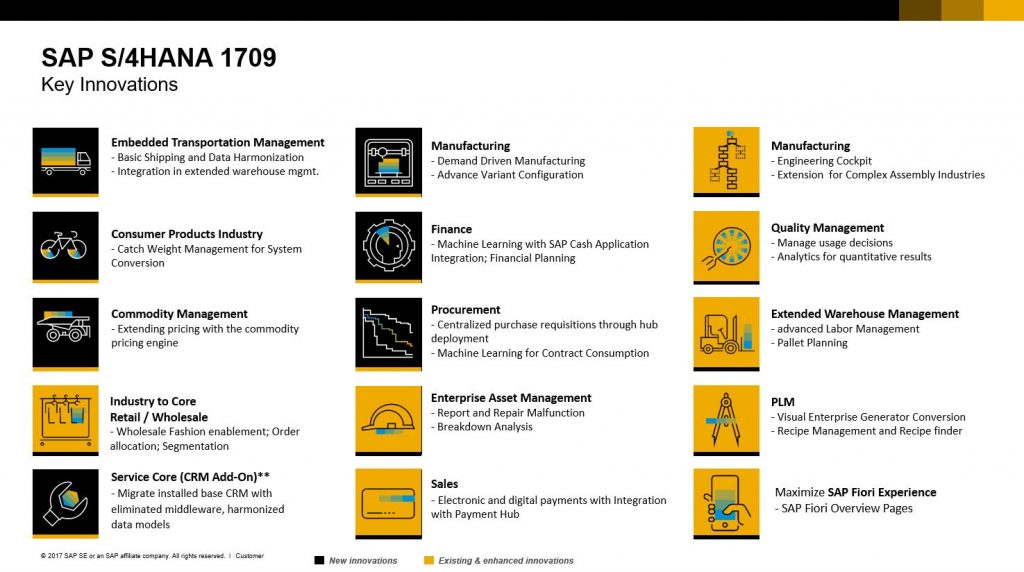
SAP has released SAP S/4HANA 1709 as of September 15th, 2017. The architectural evolution of the new release, the latest tools which are now available for SAP S/4HANA adoption, and the functional innovations and enhancements.
Architectural evolution
The SAP S/4HANA 1709 release is now generally available. This release runs on SAP HANA 2, the second generation of SAP’s in-memory database platform, which supports scale-out and usage of active-active for added performance. This enables customers to benefit from the latest innovations in the database system.
Expanding the core
With SAP S/4HANA 1709, we’ve expanded our core by including, for example, embedded transportation management. Previously, customers had to use two systems and the corresponding integration. Now, all transportation processes come together in one system. This helps to reduce data redundancy enabling customers to run simple.
SAP also added Catch Weight Management. With this feature, customers use a parallel, variable quantity in inventory management to valuate goods’ movements independently of their logistic quantities. Catch Weight Management is specialized in covering the needs of the consumer products industry in general, and the food processing industry in particular, making it easier to convert their existing systems. Therefore, Catch Weight Management provides customers with processes and functions to manage materials in two independent units of measure throughout the main inventory management.
Innovating the core
With the new release, there are also some brand-new capabilities. Let me share some favorites, like demand-driven replenishment. With the demand-driven buffer level management, customers can now plan and manage supply chains more efficiently. Providing decoupling points with strategic stock positions, manufacturers can now avoid the so-called “Bull-Whip-Effect”, where the variation in demand increases as you move further up the supply chain from customer to supplier.
Another new process is advanced variant configuration. Variant configuration is for manufacturing complex products. The manufacturer must always offer new variants of his products. Often, new variants are created by modifying existing product designs as you process the order. It is important to react quickly to customers’ requirements. With the new functionality in SAP S/4HANA 1709, customers are provided with efficient and transparent application support throughout the business process (end-to-end), which is key for their companies.
New tools for SAP S/4HANA adoption
If a customer wants to move from an SAP ERP system to SAP S/4HANA, we distinguish between three transition scenarios:
- New Implementation: When customers migrate from a legacy system to a greenfield implementation or a net-new installation
- System conversion: When customers want to change their current SAP system to SAP S/4HANA
- Landscape transformation: For customers who want to consolidate their landscape or carve out selected entities (like a company code) or processes into an SAP S/4HANA system
SAP S/4HANA 1809
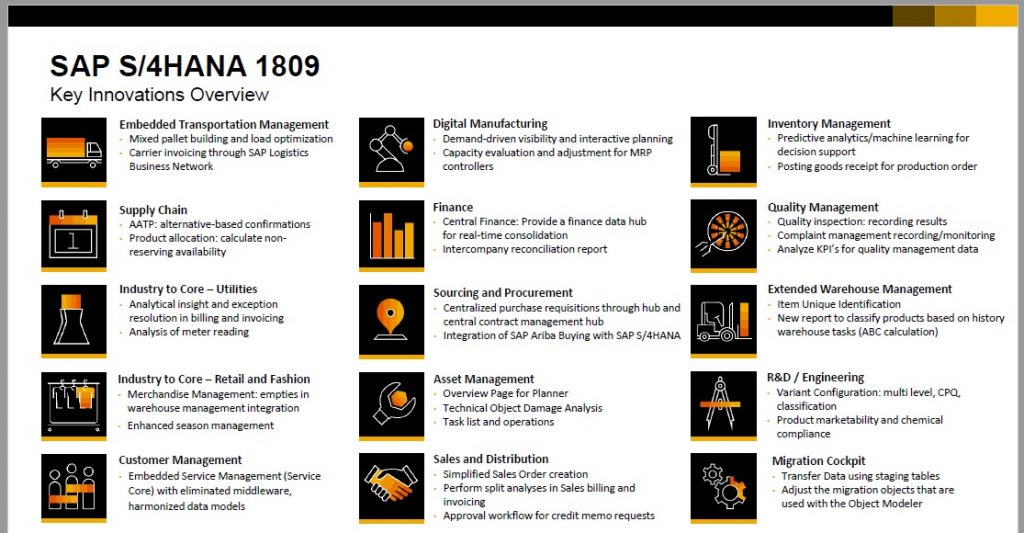
SAP announced the availability of SAP S/4HANA 1809 in September of 2018. 1809 includes a number of technical advances that augment the evolving digital core and the new “Intelligent ERP” approach that defines the S/4HANA strategy. It also introduces a range of functional and industry-specific innovations.
AP S/4HANA is the foundation of the “intelligent enterprise”, and comes as an innovative, robust and scalable core ERP. The core ingredients of the intelligent ERP are:
- A digital age UX: aiming at hands-free experience, powered by digital assistance, and delivering value-adding experiences by instant insights leveraging the latest SAP Fiori technology
- Automation: ERP augmented by machine learning from SAP Leonardo, and predictive analytics to increase automation and efficiency
- Next-generation processes: reinventing and redefining processes with applied best practices built on the latest innovations
Innovations and Intelligence in SAP S/4HANA 1809
In the area of Procurement, we’re delivering s number of Machine Learning capabilities with 1809, for example:
- Increased invoice automation and efficient invoice monitoring for exception handling
- Reduction of free-text items by automatically proposing the creation of a new catalog item
- Proposal of material group for free-text items in purchase requisitions
- Provision of options for materials without source of supply
Quotation Conversion Rates is an innovation in Sales and Distribution which truly delivers on the promise of an intelligent ERP. As an internal sales representative or a sales manager, you can use Quotation Conversion Rates to track to what extent your quotations are being converted into sales orders before expiring. By leveraging machine learning capabilities, you can gain predictive insights into quotation conversion by comparing actual and predicted results. The Quotation Conversion Probability (also known as Order Probability) is the probability that a quotation item will be converted into a sales order item. The probability, expressed as a percentage, and net value of the quotation is used in order to calculate a total expected order value.
In Manufacturing we’re introducing Demand-driven replenishment. With the demand-driven buffer level management, you can plan and manage supply chains much more efficiently. Providing decoupling points with strategic stock positions, manufacturers can avoid the so-called “Bull-Whip-Effect”, where the variations in demand increases as you move further up the supply chain from customer to supplier.
Moreover, in inventory management, we included intelligence by leveraging predictive analytics and machine learning for decision support.
Finance as well has quite a few intelligent innovations in store for you, for example predictive accounting. When a sales order is confirmed in the system, this is not recorded in accounting until goods have been delivered and the invoice has been sent. With the predictive accounting functionality, based on the sales order, a predictive goods issue and a predictive invoice is registered. This will initially be supported for selective sales processes.
Last but not least, we’ve also developed many new use cases for our digital assistant, the SAP CoPilot. The SAP CoPilot allows you to communicate with SAP S/4HANA using natural language via voice or text, and it is a first big step to deliver a hands-free ERP. With the SAP CoPilot, you can ask the system, for example, to show sales orders for a specific company from this week, to show standard orders changed by a specific person, to show sales orders with a specific customer reference. In Procurement, the SAP CoPilot enables Smart Buying by creating purchase requisitions using natural language.
SAP S/4HANA 1909
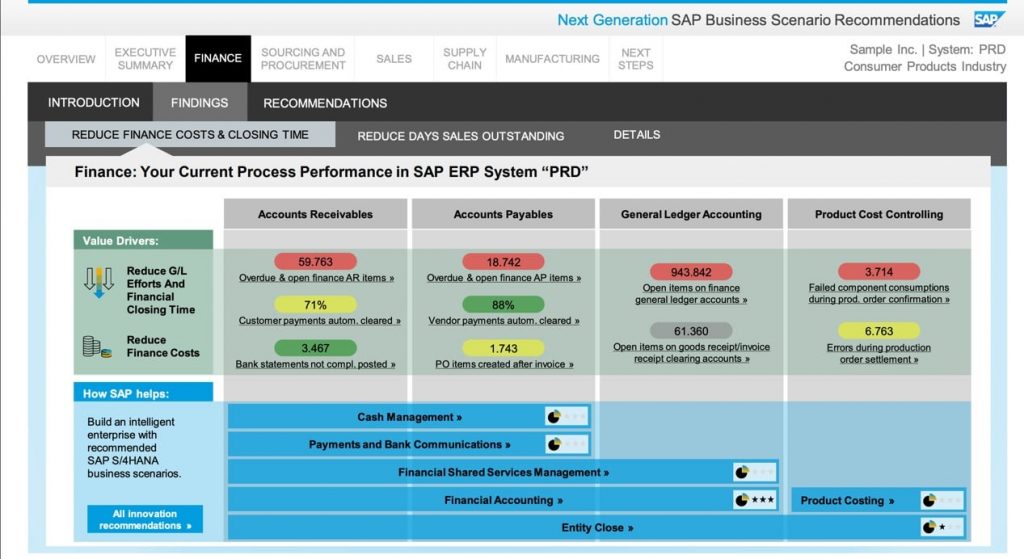
Intelligent automation, insight and prediction, next-generation processes: SAP S/4HANA 1909 brings many new and innovative capabilities to the market.
With the 1909 release of SAP S/4HANA, SAP continues to focus on delivering leading-edge value in three key areas: intelligent automation, insight and prediction, and next-generation best practices. And tremendous progress can be seen across all lines of business.
Here are some key highlights:
- In finance, improvements in the continuous closing process will drive increased process efficiency and faster insights into your business. Integration of SAP Analytics Cloud with financial planning provides quicker, clearer insight so you can run your business more effectively. Get more details here.
- In manufacturing, intelligent robotic process automation (IRPA) helps deliver predictive material resource planning (pMRP) so you can better serve your customers while reducing inventory costs.
- Predictive analytics now helps improve sales forecasts and delivery performance. Added blockchain capabilities make supplier quotes more secure.
- Improved integration across all lines of business drives end-to-end processes that lead to improved customer-centricity. Get more detail on capabilities of the 1909 release here.
SAP Business Scenario Recommendations
How do you apply all of these SAP S/4HANA innovations to your business? SAP has just released a new version of the SAP Business Scenario Recommendations service. Free to all SAP customers on maintenance, this service looks at five lines of business — finance, sales, manufacturing, procurement, and supply chain — and evaluates the performance of your SAP ERP business processes against benchmarks in your industry.
It then shows how SAP S/4HANA can improve your company performance by looking at key performance indicators in your industry and showing how these could improve in your company by implementing SAP S/4HANA.
I encourage you to spend some time getting to know how SAP Business Scenario Recommendations can help you build a case for a move to SAP S/4HANA.
SAP S/4HANA 1909: The Big Picture
While the list of new capabilities in SAP S/4HANA 1909 is extensive, it is important and consider the big picture. In 2017, the number of SAP S/4HANA innovations was 966, in 2018 it was 2,389, and now, in 2019, it stands at 3,312: an increase of almost 3.5 times! User experience (UX) innovations have gone from 646 to 1,048, and to now 1,496 – up by more than double in three releases.
